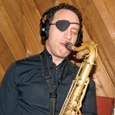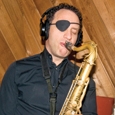Whether you are a greenhorn or the star player, there is nothing like taking a lesson with a seasoned pro to spark your art. Every teacher will give you a different gift. One of my early piano teachers, Julian White, brought the great composers to life for me and taught me how to play classical music with heart. He was also one of the funniest people I have ever met, telling me at one point that my hand position resembled Bob Hope’s nose.
During my pre and early teens, saxophonist Steve Elson taught me to improvise and play jazz. Then he showed me how to avoid becoming a jazz snob – that there was a huge world of music to explore; that being a musician is a narrow enough highway without closing any lanes. Then there was Phil Hardymon, the biggest influence on my career after my family.
Phil worked as a trumpet player in New York in the 1950s until he lost the use of a lung in a car accident. He moved to Berkeley and, along with Herb Wong and Dick Whittington, dedicated his life to raising music in the public schools to unprecedented levels of excellence. Suffice it to say that by the age of fifteen, we were performing at the Monterey Jazz Festival, winning every big band and small ensemble award in California and Nevada, performing our own music in and around San Francisco, and developing the technical and psychological skills necessary to survive the musician’s life. Phil turned us into dedicated musicians with a sharp eye on reality; he treated us like adults, so we played like adults. His alumni – including Peter Apfelbaum, Steven Bernstein, Rodney Franklin, Benny Green, Craig Handy, Paul Hanson, Jessica Jones, and Joshua Redman – are doing pretty well. Phil Hardymon was an extraordinary teacher.
When I was 17 I had the great privilege of studying with jazz legend Joe Henderson. During my first lesson, Joe taught me the first sixteen bars of John Coltrane’s solo on Countdown by ear, one note at a time. Since the tempo was so fast and the harmonic structure so complex, I had never considered trying to memorize it. I still know those sixteen bars better than any other piece of music.
If you are not blessed with an award-winning school music program, or if you can’t afford equipment and lessons, swap ideas, methods, riffs, instruments, supplies, sheet music, and books with your peers. Just talking with a smart musician can work wonders. Take advantage of continuing education courses at your local college; many offer music courses at various times of the day and night. You are never too old to go back to school.
If you currently study music in a college or music school, you probably have cultivated good relationships with music teachers throughout your life. I can only suggest keeping up the good work; pay attention to what each teacher offers. Ask good questions and follow the professor down the garden path. At minimum, you will find out what you don’t want to play.
The well-rounded musician should also acquire students to teach If you only have time for one pupil every two weeks, begin there. To teach is to learn. When you review your own early training and explain basic concepts in new ways you will challenge and stimulate yourself, not just your students. And there is nothing more rewarding than helping beginners and amateurs become full-fledged professionals. I feel fortunate that many of my students have gone on to do great things.
I have taught since I was fifteen. My price has not changed since then, because I do not want to exclude students with limited funds. I accept students of all ages and abilities. At any given point I’ll have a couple toddlers in early music lessons; a dozen middle school students and teenagers studying either piano, saxophone, flute, or composition; several music therapy students; a wide ranging group of professional musicians in various stages of their careers; and several senior citizens, most of whom had lousy music teachers as kids. Because I enjoy teaching, I bend over backwards to accommodate various schedules, personality types, and proclivities. It is not always easy work, but the joys far out way the sorrows.
I would be lying if I said I did not have favorite students. The good students listen to everything I say and play, and they listen at home. They ask good questions. They expose me to music I have never heard and complete their assignments.
Back in the 70s, I received a call from a nice woman who asked me if I would teach her son, Joshua Redman, because his father, Dewey, was living in New York. Dewey Redman was one of my favorite saxophonists, and I was flattered, but felt like I was way in over my head. She insisted, though, and I gave Josh his first five or six lessons. I’m sorry to report that he had a short attention span, no apparent musical aptitude, and little interest in the saxophone. What a difference a couple decades makes! I don’t know if Josh remembers these lessons and wouldn’t be offended if he has blocked them out.
I have also worked extensively with both individuals and groups with various physical and mental impairments. You only need to see a severely-withdrawn autistic kid respond to the blues to appreciate the power of music. The abstract nature of music helps us reach mysterious recesses of the human brain in ways that mere science cannot fully explain. How does music heal? I suspect that there are lasting benefits from the spontaneous synaptic connections triggered by music. When the student or patient is able to play an instrument even a little, the benefits increase exponentially. Regardless of the details, I have found that using music to help people is deeply satisfying, and it forces me to use my own brain in new ways.
Hopefully you will also have some students who outdo you in certain areas. I have had Eastern European students whose double and triple-tonguing (possibly from playing Polkas and such) floored me. Sometimes my students surprise me with a new take on a tired subject. They always inspire me to practice.
It is not difficult to find students. Most of my students came to me by word of mouth or approached me at gigs. You can also try putting up posters on the bulletin boards at your local school, grocery store, and community center. Get on all the teacher lists you can, and cultivate relationships with local colleges. Websites like Craigslist can work, but you will likely get more spam than legitimate inquiries. Tell friends and colleagues that you are looking for students, and perform at your local school. The relationship between student and teacher is precious and should be fully explored.






